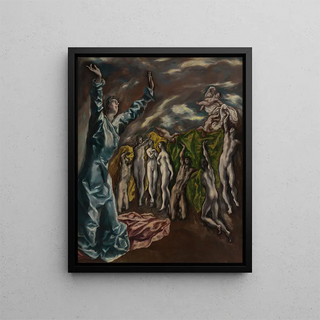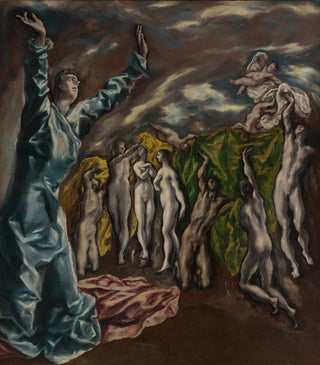Painting The Vision of Saint John - El Greco | Art print


View from behind

Frame (optional)
In the fascinating universe of art, some works transcend time and space, captivating the mind and soul of viewers. "The Vision of Saint John" by El Greco is one of these majestic creations. Painted at the turn of the 17th century, this iconic canvas depicts a mystical scene where the saint, immersed in spiritual contemplation, receives divine revelations. The emotional power of this piece lies in its ability to evoke deep feelings and transport the viewer to a realm where the sacred and the profane meet. The dynamic use of colors and the depth of forms invite a contemplative experience, making this art print a true masterpiece to incorporate into any living space.
Style and uniqueness of the work
El Greco, master of expressionism, developed a unique style characterized by elongated figures and intense colors. In "The Vision of Saint John," the angular features and expressive faces of the characters illustrate a dramatic tension, almost palpable. The light, omnipresent, seems to emanate from within the figures themselves, creating a striking contrast with the shadows that envelop the scene. The composition, bold and dynamic, guides the viewer’s gaze across the painting, revealing a universe where the spiritual takes precedence over the material. The shades of blue and gold, typical of the artist’s style, enhance the mystical dimension of the work. Every brushstroke is an invitation to explore the mysteries of faith and revelation, making this piece a centerpiece of Western art.
The artist and his influence
Born in Crete in 1541, Doménikos Theotokópoulos, better known as El Greco, left his mark on his era with an innovative artistic vision. His journey took him from the Italian Renaissance to the Spanish court, where he established himself as one of the most influential artists of his time. His ability to fuse Byzantine traditions with Western techniques opened new avenues for Spanish art. El Greco inspired many artists, from the Baroque period to Impressionism.

Matte finish

View from behind

Frame (optional)
In the fascinating universe of art, some works transcend time and space, captivating the mind and soul of viewers. "The Vision of Saint John" by El Greco is one of these majestic creations. Painted at the turn of the 17th century, this iconic canvas depicts a mystical scene where the saint, immersed in spiritual contemplation, receives divine revelations. The emotional power of this piece lies in its ability to evoke deep feelings and transport the viewer to a realm where the sacred and the profane meet. The dynamic use of colors and the depth of forms invite a contemplative experience, making this art print a true masterpiece to incorporate into any living space.
Style and uniqueness of the work
El Greco, master of expressionism, developed a unique style characterized by elongated figures and intense colors. In "The Vision of Saint John," the angular features and expressive faces of the characters illustrate a dramatic tension, almost palpable. The light, omnipresent, seems to emanate from within the figures themselves, creating a striking contrast with the shadows that envelop the scene. The composition, bold and dynamic, guides the viewer’s gaze across the painting, revealing a universe where the spiritual takes precedence over the material. The shades of blue and gold, typical of the artist’s style, enhance the mystical dimension of the work. Every brushstroke is an invitation to explore the mysteries of faith and revelation, making this piece a centerpiece of Western art.
The artist and his influence
Born in Crete in 1541, Doménikos Theotokópoulos, better known as El Greco, left his mark on his era with an innovative artistic vision. His journey took him from the Italian Renaissance to the Spanish court, where he established himself as one of the most influential artists of his time. His ability to fuse Byzantine traditions with Western techniques opened new avenues for Spanish art. El Greco inspired many artists, from the Baroque period to Impressionism.
12,34 €






